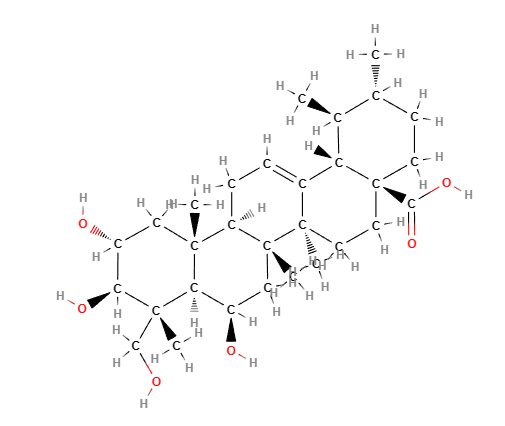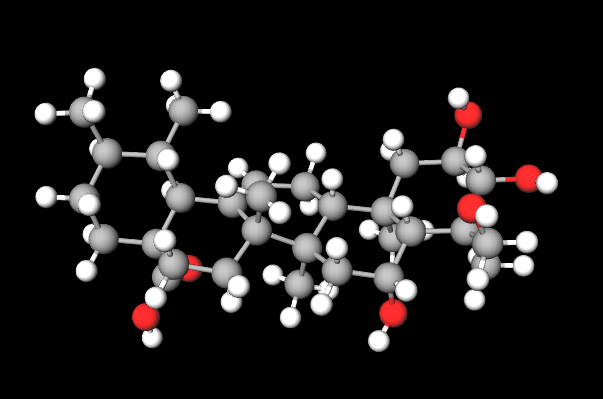Check the ingredients!
... live healthy!


| "Descrizione" by A_Partyns (12876 pt) | 2024-May-10 16:21 |
Madecassic Acid is a triterpenoid derived from Centella Asiatica, known for its anti-inflammatory and regenerative properties.
Industrial Production Process
What it is used for and where
Madecassic Acid is an active ingredient used in cosmetic formulations for its ability to promote cell regeneration and reduce inflammation. It stimulates collagen production and helps strengthen the skin barrier, reducing the appearance of wrinkles and fine lines. This acid is often used in anti-aging products like serums and creams, where it provides regenerative benefits and helps maintain smooth, healthy skyn.
Cosmetics - INCI Functions
Cosmetic Applications
Skin Regeneration. Madecassic acid stimulates collagen production and promotes cell regeneration, helping to improve the appearance of scars and signs of aging.
Anti-inflammatory Effects. Reduces skin inflammation, making it ideal for treating sensitive, inflamed, or damaged skin.
Antioxidant Properties. Protects the skin from free radical damage, preventing premature aging, maintaining healthy skin and protecting it with antibacterial action (1).
Soothing Effects. Calms and soothes irritated skin, helping reduce redness and improve wound healing.
Versatile Applications. It can be incorporated into various cosmetic products, such as serums, creams, lotions, and masks, for its anti-inflammatory and regenerative properties.
Other Applications
Wound Healing. Used in ointments and creams to promote wound and ulcer healing thanks to its ability to stimulate new tissue formation (2).
Anti-inflammatory Properties. Studied for its anti-inflammatory properties (3), madecassic acid may be useful in treating chronic inflammatory conditions and osteoarthritis by restoring the integrity of the chondrocyte cytoskeleton (4).
Pharmaceutical Industry. Used in pharmaceutical products for its protective and healing action.
 |  |
Molecular Formula C30H48O6
Molecular Weight 504.7 g/mol
CAS 18449-41-7
UNII M7O1N24J82
EC Number 606-031-1
DTXSID70939838
Synonyms:
Brahmic acid
Bibliografia_____________________________________________________________________
(1) Wei C, Cui P, Liu X. Antibacterial Activity and Mechanism of Madecassic Acid against Staphylococcus aureus. Molecules. 2023 Feb 16;28(4):1895. doi: 10.3390/molecules28041895.
Abstract. Antibacterial resistance has become one of the most serious problems threating global health. To overcome this urgent problem, many scientists have paid great attention to developing new antibacterial drugs from natural products. Hence, for exploring new antibacterial drugs from Chinese medicine, a series of experiments were carried out for verifying and elucidating the antibacterial activity and mechanisms of madecassic acid (MA), which is an active triterpenoid compound isolated from the traditional Chinese medicine, Centella asiatica. The antibacterial activity was investigated through measuring the diameter of the inhibition zone, the minimum inhibitory concentration (MIC), the growth curve, and the effect on the bacterial biofilm, respectively. Meanwhile, the antibacterial mechanism was also discussed from the aspects of cell wall integrity variation, cell membrane permeability, and the activities of related enzymes in the respiratory metabolic pathway before and after the intervention by MA. The results showed that MA had an inhibitory effect on eight kinds of pathogenic bacteria, and the MIC values for Staphylococcus aureus, Methicillin-resistant Staphylococcus aureus, Escherichia coli, Pseudomonas aeruginosa, Bacillus subtilis, and Bacillus megaterium were 31.25, 62.5, 250, 125, 62.5, and 62.5 µg/mL, respectively. For instance, 31.25 µg/mL MA could inhibit the growth of Staphylococcus aureus within 28 h. The antibacterial mechanism experiments confirmed that MA could destroy the integrity of the cell membrane and cell wall of Staphylococcus aureus, causing the leakage of macromolecular substances, inhibiting the synthesis of soluble proteins, reducing the activities of succinate dehydrogenase and malate dehydrogenase, and interacting with DNA, leading to the relaxation and ring opening of supercoiled DNA. Besides, the activities of DNA topoisomerase I and II were both inhibited by MA, which led to the cell growth of Staphylococcus aureus being repressed. This study provides a theoretical basis and reference for the application of MA in the control and inhibition of food-borne Staphylococcus aureus.
(2) Wu F, Bian D, Xia Y, Gong Z, Tan Q, Chen J, Dai Y. Identification of Major Active Ingredients Responsible for Burn Wound Healing of Centella asiatica Herbs. Evid Based Complement Alternat Med. 2012;2012:848093. doi: 10.1155/2012/848093.
Abstract. Centella asiatica herbs have been prescribed as a traditional medicine for wound healing in China and Southeast Asia for a long time. They contain many kinds of triterpenoid compounds, mainly including glycosides (asiaticoside and madecassoside) and corresponding aglycones (asiatic acid and madecassic acid). To identify which is the major active constituent, a comprehensive and comparative study of these compounds was performed. In vitro, primary human skin fibroblasts, originating from healthy human foreskin samples, were treated with various concentrations of asiaticoside, madecassoside, asiatic acid, and madecassic acid, respectively. Cell proliferation, collagen synthesis, MMP-1/TIMP-1 balance, and TGF-β/Smad signaling pathway were investigated. In vivo, mice were orally administered with the four compounds mentioned above for two weeks after burn injury. The speed and quality of wound healing, as well as TGF-β(1) levels in skin tissues, were examined. Interestingly, in contrast to prevalent postulations, asiaticoside and madecassoside themselves, rather than their corresponding metabolites asiatic acid and madecassic acid, are recognized as the main active constituents of C. asiatica herbs responsible for burn wound healing. Furthermore, madecassoside is more effective than asiaticoside (P = 0.0446 for procollagen type III synthesis in vitro, P = 0.0057 for wound healing speed, and P = 0.0491 for wound healing pattern in vivo, correspondingly).
(3) Won JH, Shin JS, Park HJ, Jung HJ, Koh DJ, Jo BG, Lee JY, Yun K, Lee KT. Anti-inflammatory effects of madecassic acid via the suppression of NF-kappaB pathway in LPS-induced RAW 264.7 macrophage cells. Planta Med. 2010 Feb;76(3):251-7. doi: 10.1055/s-0029-1186142.
Abstract. We have investigated the anti-inflammatory effects of madecassic acid and madecassoside isolated from Centella asiatica (Umbelliferae) on lipopolysaccharide (LPS)-stimulated RAW 264.7 murine macrophage cells. Both madecassic acid and madecassoside inhibited the production of nitric oxide (NO), prostaglandin E(2) (PGE(2)), tumor necrosis factor-alpha (TNF-alpha), interleukin-1 beta (IL-1beta), and IL-6. However, madecassic acid more potently suppressed these inflammatory mediators than did madecassoside. Consistent with these observations, madecassic acid inhibited the LPS-induced expression of iNOS and COX-2 at the protein level and of iNOS, COX-2, TNF-alpha, IL-1beta, and IL-6 at the mRNA level in RAW 264.7 macrophage cells, as determined by Western blotting and RT-PCR, respectively. Furthermore, madecassic acid suppressed the LPS-induced activation of nuclear factor-kappaB (NF-kappaB), and this was associated with the abrogation of inhibitory kappa B-alpha (IkappaB-alpha) degradation and with the subsequent blocking of p65 protein translocation to the nucleus. These results suggest that the anti-inflammatory properties of madecassic acid are caused by iNOS, COX-2, TNF-alpha, IL-1beta, and IL-6 inhibition via the downregulation of NF-kappaB activation in RAW 264.7 macrophage cells.
(4) Fu X, He S, Wang L, Xue Y, Qiao S, An J, Xia T. Madecassic Acid Ameliorates the Progression of Osteoarthritis: An in vitro and in vivo Study. Drug Des Devel Ther. 2022 Nov 1;16:3793-3804. doi: 10.2147/DDDT.S383632.
| Evaluate |